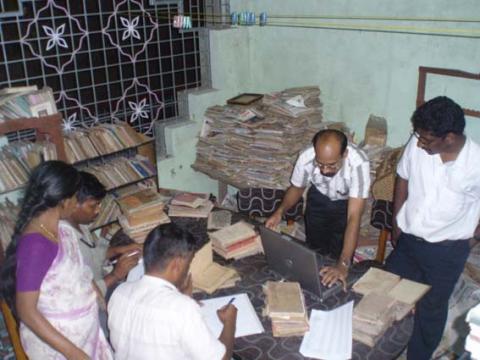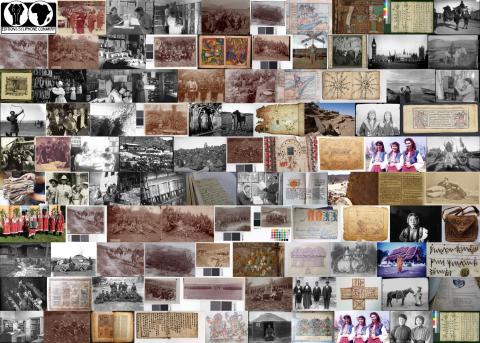
Aims and objectives
This major project will create the first archive of Tamil studio photography, namely family portraiture, from the time of the introduction of commercial photo studios in the second half of the 19th century up to the introduction of mechanised photographic processing. The project aims to cover the different productions of black and white manually processed studio photography (prints, negatives and glass plates) which are rapidly disappearing either through natural degradation or, in many cases, voluntary destruction. The feasibility of creating this archive was explored in the pilot project EAP737 through the survey of 100 studios in 14 localities.
Over the last 25 years, the 'visual turn' in South Asian Studies, has afforded glimpses into numerous visual media produced in the Indian subcontinent over the last century and a half. Concerning the field of Indian photography, the vast majority of publications and archives concern colonial practices of photography and north or central Indian appropriations of the photographic media during the 20th century. The productions of South Indian studio photographers are largely unexplored and no archive exists to foster research on this vast and rich topic of study. The material will provide visual evidence of Tamil society at moments of crucial social and cultural changes.
The photographic productions of Tamil studios are extremely endangered for the very obvious reason of the particularly detrimental tropical climate of southern India with its year-long high ratio of humidity. There are however further factors which have resulted in a vast destruction of a large part of material and a further deterioration of what is still remaining: for over a half a century, if not longer, studios have been regularly and voluntarily destroying their archives by selling negatives (glass and film) to silver-extractors (several of them were met during the pilot project EAP 737); many of the earliest studios have closed over the last 30 years and the descendants of studio photographers have no interest or understanding for their forefathers' photographic productions; the situation is similar for photographers still practising in the family studio. Even the minimal preservation conditions for negatives and prints is unheard of.
Photography arrived in India in the 1840s. The first photographic society in South India was created in Madras in 1856. During the early decades of Indian photography, photography was accessible almost exclusively to the colonial administration and Indian elite. However by the 1880s, commercial photography studios had found their way into the bazaars of the Presidency’s and family portraits started to appear inside Tamil households. It is important to note that, in South India, prior to the coming of commercial photography, there existed no local forms of popular portraiture aside from the representations of divinities.
Tamil portrait photography, often facing restricted access to technological improvements, rapidly developed into a rich practice, where technical inventions, ingenious adaptations and artistic achievements rubbed shoulders. The early Tamil commercial studio photographers created their own visual language to represent south India selves and families. Their idioms combined the uses of props, accessories, backdrops, over-painting, collage, montage. Throughout the first half of the 20th century, constraints imposed by high costs and difficulties in importing recent photographic equipment resulted in the 'prolonged' use by small family-run studios of older photographic processes and equipment.
The advent of mechanised processing and printing, of colour photography (both in the 1980s) followed by the digital revolution (mid 1990s) radically transformed photographic practices and production. A very large number of studios closed down (and their archives often –but not always– lost) as they could not financially manage to acquire the expensive equipment necessary. The studios that did manage to survive these successive technological revolutions discarded manual processing and printing of black and white portraiture which had been the trade and skill for over a century.
The EAP 946 archive would provide researchers with unique visual material and metadata of Tamil society at moments of crucial social and cultural changes. Besides the study of photographic processes and mediums throughout history, of the evolutions of representation of women and men, a wide range of issues could be investigated such as the consequences of the introduction of photo portraits in the homes, the ways in which these have affected vernacular notions of individuality and dual dimension of personhood (akam/interior and puram/exterior), their impact on representations of marriage from alliance to conjugality, the uses of family portraits as hybrid photo-objects subject to daily domestic ritual venerated alongside chromolithographs of divinities in Tamil households, the transformation of regional and sectarian dress codes etc.
Outcomes
31,780 images (63 collections) were digitised, out of which 17,232 (34 collections) were catalogued and sent to EAP.
The team digitised photographic collections in 15 localities across Tamil Nadue: Chennai, Coimbatore, Coonoor, Karaikudi, Kothmangalam, Kumbakonam, Madurai, Mayiladuthurai, Pondicherry, Pudukottai, Tanjore, Tindivanam, Tiruchirapally (Trichy), Tirunelveli, Yercaud.
If you are interested in the images that were not submitted to EAP, please contact the French Insitutute of Pondicherry.



